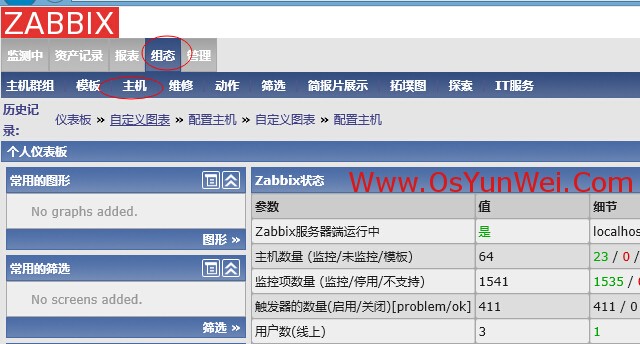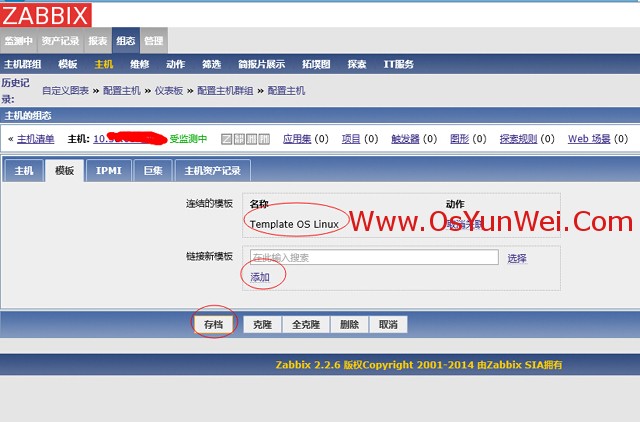
Instructions:
The Zabbix monitoring server has been configured. Now you need to use Zabbix to monitor the Linux host.
Specific operations:
The following operations are performed on the monitored Linux host. Here we take the CentOS 6.x system as an example.
1. Configure the firewall and open TCP and UDP ports 10050 and 10051
vi /etc/sysconfig/iptables #Edit the firewall configuration file
-A INPUT -s 192.168 .21.127 -m state --state NEW -m tcp -p tcp --dport 10050:10051 -j ACCEPT
-A INPUT -s 192.168.21.127 -m state --state NEW -m udp -p udp --dport 10050:10051 -j ACCEPT
:wq! #Save and exit
service iptables restart #Restart the firewall to make the configuration effective
Explanation: 192.168.21.127 is Zabbix The IP address of the server means that the port is only open to this IP. If it is to be open to all IPs, the rules are as follows:
-A INPUT -m state --state NEW -m tcp -p tcp --dport 10050: 10051 -j ACCEPT
-A INPUT -m state --state NEW -m udp -p udp --dport 10050:10051 -j ACCEPT
2. Close SELINUX
vi /etc/selinux/config
#SELINUX=enforcing #Comment out
#SELINUXTYPE=targeted #Comment out
SELINUX=disabled #Add
:wq! #Save and exit
setenforce 0 #Make the configuration take effect immediately
3. Install Zabbix client
1. Download zabbix software package
zabbix-2.2.6
http://jaist.dl.sourceforge.net/project/zabbix/ZABBIX%20Latest%20Stable/2.2.6/zabbix-2.2.6.tar.gz
Upload zabbix-2.2.6.tar.gz to the server/usr/local/src directory
2. Add user
groupadd zabbix #Create user group zabbix
useradd zabbix -g zabbix -s /bin/false #Create user zabbix and add user zabbix to user group zabbix
3. Install Zabbix
ln -s /usr/local /lib/libiconv.so.2 /usr/lib/libiconv.so.2 #Add soft connection
/sbin/ldconfig #Make the configuration take effect immediately
cd /usr/local/src
tar zxvf zabbix-2.2.6.tar.gz
cd zabbix-2.2.6
./configure --prefix=/usr/local/zabbix -- enable-agent #Configuration
make #Compile
make install #Install
ln -s /usr/local/zabbix/sbin/* /usr/local/sbin/ #Add system soft connection
ln -s /usr/local/zabbix/bin/* /usr/local/bin/ #Add system soft connection
Note: Compiling and installing software needs to be installed first Compilation tools and other system software packages, CentOS uses the following command to install
yum install apr* autoconf automake bison cloog-ppl compat* cpp curl curl-devel fontconfig fontconfig-devel freetype freetype* freetype-devel gcc gcc-c++ gtk+ -devel gd gettext gettext-devel glibc kernel kernel-headers keyutils keyutils-libs-devel krb5-devel libcom_err-devel libpng* libjpeg* libsepol-devel libselinux-devel libstdc++-devel libtool* libgomp libxml2 libxml2-devel libXpm* libtiff libtiff* libX * make mpfr ncurses* ntp openssl openssl-devel patch pcre-devel perl php-common php-gd policycoreutils ppl telnet t1lib t1lib* nasm nasm* wget zlib-devel
4. Add the port corresponding to the zabbix service
echo 'zabbix-agent 10050/tcp #Zabbix Agent' >> /etc/services
echo 'zabbix-agent 10050/udp #Zabbix Agent' >> /etc/services
echo 'zabbix-trapper 10051/tcp #Zabbix trapper' >> /etc/services
echo 'zabbix-trapper 10051/udp #Zabbix trapper' >> /etc /services
or
vi /etc/services #Edit, add the following code at the end
# Zabbix
zabbix-agent 10050/tcp # Zabbix Agent
zabbix-agent 10050/udp # Zabbix Agent
zabbix-trapper 10051/tcp # Zabbix Trapper
zabbix-trapper 10051/udp # Zabbix Trapper
:wq! #Save and exit
5. Modify Zabbix configuration file
vi /usr/local/zabbix/etc/zabbix_agentd.conf #Edit
Server=192.168 .21.127
Include=/usr/local/zabbix/etc/zabbix_agentd.conf.d/
UnsafeUserParameters=1 #Enable custom key
:wq! #Save Exit
Note: 192.168.21.127 is the Zabbix server IP address
6. Add the boot script
cp /usr/local/src/zabbix-2.2.6/ misc/init.d/fedora/core/zabbix_agentd /etc/rc.d/init.d/zabbix_agentd
vi /etc/rc.d/init.d/zabbix_agentd #Edit
BASEDIR=/usr/local/zabbix/ #Zabbix installation directory
:wq! #Save and exit
chmod +x /etc/rc.d/init.d/zabbix_agentd #Add script execution Permissions
chkconfig zabbix_agentd on #Add boot startup
service zabbix_agentd start #Start Zabbix client
ps ax|grep zabbix_agentd #Check whether Zabbix client is running normally
netstat -utlnp | grep zabbix #Check whether the Zabbix client is running normally
4. Test whether the communication between the Zabbix client and the Zabbix server is normal
The following code is executed on the Zabbix server
/usr/local/zabbix/bin/zabbix_get -s192.168.21.128 -p10050 -k"system.uptime"
5049866 #If data is displayed, the communication is normal
Note: 192.168.21.128 is the Zabbix client IP address
5. Add monitoring of the Linux host
Open in the browser:
http://192.168.21.127/zabbix/ #Zabbix server access address








